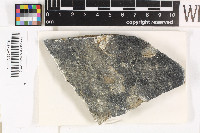
Consortium of Lichen Herbaria
- building a Global Consortium of Bryophytes and Lichens as keystones of cryptobiotic communities -
- Home
- Search
- Images
- Species Checklists
- US States: O-Z >
- US National Parks
- Central America
- South America
- US National Parks
- Southern Subpolar Region
|
|
|
|
Family: Lecideaceae
[Lecidea carbonoidea J.W. Thomson] |
Life habit: lichenized (mutualistic with algal photobionts) thallus: crustose (crustaceous) episubstratal unspecified thallus: compartimentized areolate, squamulate [th] upper surface: brown(ish) (if pale: fawn, tan; if mid: cinnamon) [th marginal and upper surface] specific structures: absent [th] morphol substructures (eg areoles, lobes, branches) width [mm]: (low) 0.1 (high) 1.0 [th] morphol substructures (eg areoles, lobes, branches) upper surface: smooth, plane [th] medulla amyloidity: present ascomata: absent | present ascoma: apothecial, apothecioid hymenial ascoma: immersed, innate [ascm, if apoth] disc, mazaedium: concave | plane, flat, flattened, expanded [ascm, if apoth] disc, mazaedium: black(ish) [ascm, if apoth] disc, mazaedium: epruinose [ascm, if apoth] margin surface; [if perith] periostiolar area, ostiole, involucrellum: black(ish) [ascm, if apoth] margin excipular photobionts: absent [ascm, if apoth] subhymenial layers, hypothecium; [if perith] basal excipulum: brown(ish) (if pale: fawn, tan; if mid: cinnamon) [ascm] paraphyses/-oids: present [ascm] paraphyses/-oid cells width [µm]: (median) 3.0 [ascm] paraphyses/-oid apical cells width [µm]: (median) 6.0 [ascm] epihymenium, epithecium: brown(ish) (if pale: fawn, tan; if mid: cinnamon) asci: lecanoralean [asc] tholus: thickened [asc] tholus amyloidity (iodine reaction): present [asc] tholus amyloidity pattern: with amyloid tube (= Collema-, Micarea-, Porpidia-, Psora-types etc) ascospores: (median) 8.0 [asp] shape: ellipsoidal [asp] length [µm]: (low) 12.0 (high) 12.5 [asp] width [µm]: (low) 6.5 (high) 7.5 [asp] septa: absent spore lumen unilocular, monolocular [asp] pigmentation: hyaline, colourless [asp] perispore, epispore: not apparent | thin, thinly halonate | thick, distincly halonate secondary metabolites: present primary photobiont: present secondary photobionts (eg in cephalodia): absent primary photobiont: chlorophytaceous trebouxiaceous, chlorococcoid. substrate: rock siliceous, siliciferous, acidic | rock, stones, pebbles unspecified. Thompson, J., 1997. American Arctic Lichens: The Microlichens. Thallus large, to 13 cm across, of tiny flat areolae 0.1-1.0 mm broad, very dark sooty brown, bordered by a black hypothallus and a pale gray margin about 3 areolae (1 mm) wide, areolae very angular, mutually pressed together, with deep chinks between, thallus thin at edges to 1 mm thick centrally. Apothecia sunken in areolae, 1 per areola, sometimes with multiple disks; disk black, concave, dull, epruinose, a thin exciple sometimes visible; exciple dark brown, paraplectenchymatous, full of inspersed crystals, joining hypothecium, which is also dark brown; epihymenium brown; hymenium pale below, brown above, 65-75 μm paraphyses coherent, not branched, not moniliform, septate, 3 μm with tips to 6 μm and brown; asci clavate; spores 8, biseriate, hyaline, often with gelatinous halo, 12-12.5 X 6.5-7.5 μm. Reactions: K—, C—, P—, 1+ blue, known thus far only from the type locality on the Pit-megea River, on the north slope of Alaska. The type locality may have been extirpated during oil pipeline development. |
Powered by Symbiota



















